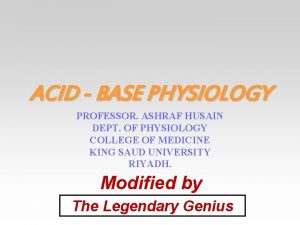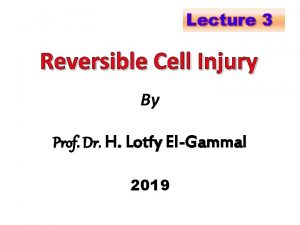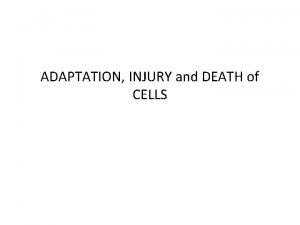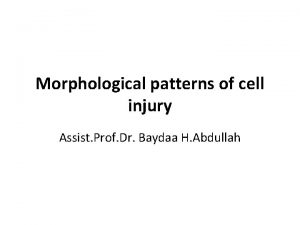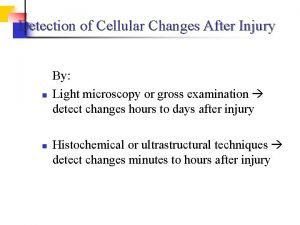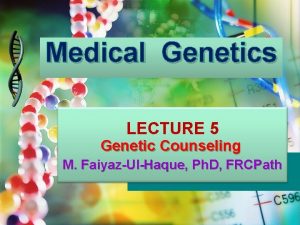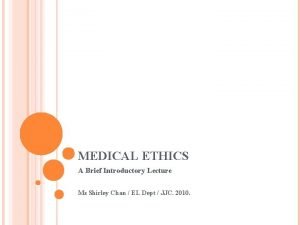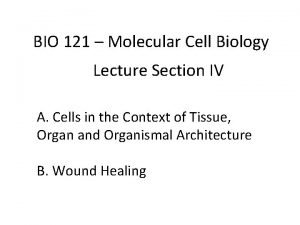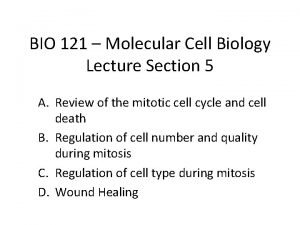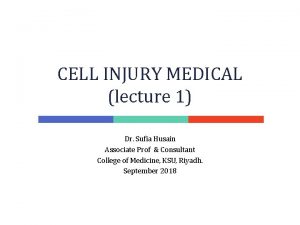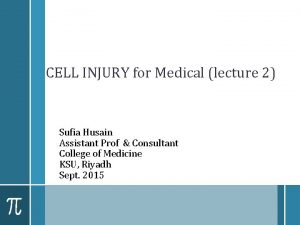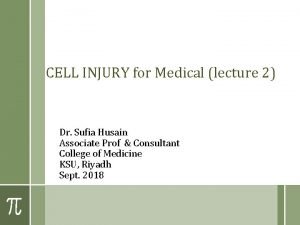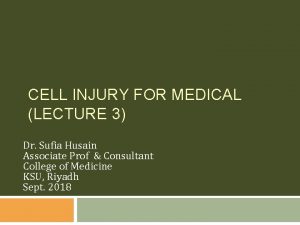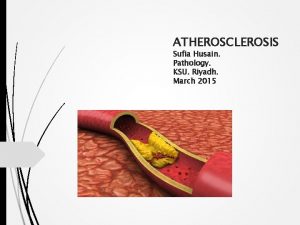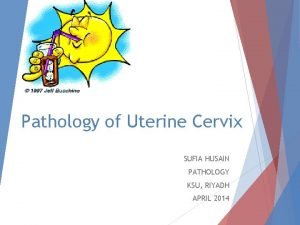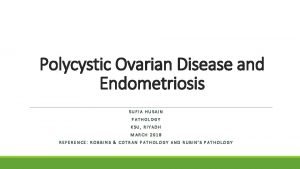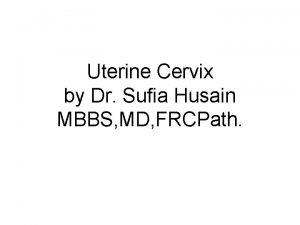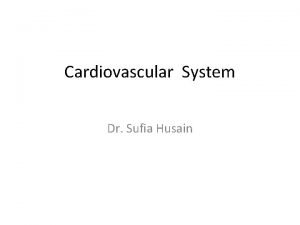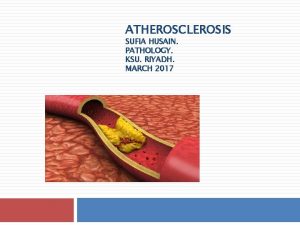CELL INJURY FOR MEDICAL LECTURE 3 Sufia Husain























- Slides: 23

CELL INJURY FOR MEDICAL (LECTURE 3) Sufia Husain Assistant Prof & Consultant KKUH, Riyadh. Oct. 2017

Lecture 3 outline 1. 2. INTRACELLULAR ACCUMULATION Reversible cellular changes and accumulations: fatty change, hyaline change, accumulations of exogenous pigments (carbon, silica, iron dust, lead and argyria). Accumulations of endogenous pigments: melanin, bilirubin, haemosiderin (haemosiderosis and haemochromatosis), lipofuscin. PATHOLOGIC CALCIFICATION: metastatic calcification and dystrophic calcification

Intracellular Accumulations Some substances can accumulate inside the cell in large amounts and cause problems in the cell and the organ. The substance may accumulate in either the cytoplasm or the nucleus. This is called as intracellular accumulation. The accumulating substance can be: (1) Substance that is present in the cell normally but has accumulated in excess, such as water, lipids, glycogen, proteins, and carbohydrates (2) An abnormal substance that is not present in the cell normally. It can be either Ø Exogenous (from outside the body) e. g. a mineral or component of bacteria etc. Ø Endogenous (from inside the body) e. g. a product of abnormal synthesis or metabolism (3) Pigments: they can be endogenous or exogenous.

Examples of some of the substances that accumulate in excess in the cell: A) LIPIDS: All major classes of lipids can accumulate in cells: Ø Triglycerides e. g. steatosis (fatty change) Ø cholesterol/cholesterol esters (accumulation of cholesterol in the form of intracellular vacuoles can be seen in atherosclerosis in which there is accumulation of cholesterol in the smooth muscle cells and macrophages in the wall of arteries). Ø and phospholipids B) GLYCOGEN: C) PIGMENTS: exogenous and endogenous

Accumulation of triglycerides: Steatosis (Fatty Change) Fatty change is the abnormal accumulation of triglycerides inside cells. It is mainly seen in liver, but it is also seen in heart, muscle, and kidney. Excess accumulation of triglycerides within the hepatocytes occurs when there is an imbalance between the uptake, utilization, & secretion of fat by the affected cell. The causes of steatosis include: Ø Ø Ø Ø Toxins e. g. alcohol abuse protein malnutrition, diabetes mellitus, obesity, Anoxia/starvation Pregnancy Severe anemia

Steatosis (Fatty Change) Morphology of Steatosis in liver: Gross: In mild cases liver looks normal. In severe cases liver is enlarged, yellow and greasy. Light microscopy: clear vacuoles in the cytoplasm displacing the nucleus to the periphery of the cell Occasionally, cells rupture, and the fat globules merge, producing a so-called fatty cysts. The lipid stains orange-red with Sudan IV or Oil Red-O stains

ACCUMULATION OF GLYCOGEN Glycogen is a readily available energy store that is present in the cytoplasm. Excessive intracellular deposits of glycogen are seen in patients with an abnormality in either glucose or glycogen metabolism. They appear as clear vacuoles within the cytoplasm. Glycogen stains pinkish/violet with mucicarmine stain or the periodic acid schiff (PAS) stain. Glycogen accumulation is seen in: Ø Diabetes mellitus: is a disorder of glucose metabolism. In this disease, glycogen is found in the proximal convoluted tubules of kidney, in liver, the β cells of the islets of Langerhans, heart muscle cells etc. Ø Glycogen storage diseases: it is a group of genetic diseases in which there is abnormal glycogen metabolism.

ACCUMULATION OF PIGMENTS are colored substances. There are: Endogenous pigments: synthesized within the body itself. Some endogenous pigments are normal constituents of cells (e. g. melanin) and others are not normal constituents of cells. Examples of endogenous pigments: Ø Lipofuscin Ø Melanin Ø Bilirubin Ø Hemosiderin Exogenous pigments: they are not synthesized within the body itself and are coming from outside the body.

Endogenous Pigments A) Lipofuscin is also known as wearand-tear or aging pigment. Lipofuscin is endogenous and causes no damage to cells. It indicates history of free radical injury and lipid peroxidation. It is yellow-brown, granular intracytoplasmic pigment It is prominent in the liver and heart of aging patients, in atrophic tissue, patients with severe malnutrition and cancer cachexia The figures are of heart muscle cells.

Endogenous Pigments cont. B) Melanin: an endogenous, nonhemoglobin, brown-black pigment normally present in the cytoplasm of melanocytes in the skin’s epidermis. It is responsible for the color of our skin. It is derived from tyrosine and stored in melanosomes of the melanocytes. The function of melanin is to prevent the harmful effects of UV light. It accumulates in large amounts in benign and malignant melanocytic tumors. In inflammatory conditions of the skin it spreads from epidermis into the underlying dermis. This is called as post inflammatory hyperpigmentation of the skin. Masson-Fontana stain is used to identify melanin. Top 2 figures: normal skin with basal melanin. Bottom figure: post inflammatory hyperpigmentation

Endogenous Pigments cont. C) Bilirubin is a yellowish pigment found in bile, a fluid made by the liver. Bilirubin is a breakdown product of heme catabolism. Most of the bilirubin is derived from the break down of hemoglobin. High levels of serum bilirubin leads to a condition called as jaundice. Jaundice (also known as icterus) is a yellowish pigmentation of the skin, the conjunctiva, the sclerae (whites of the eyes), and other mucous membranes and it is caused by high blood bilirubin levels. Urine is also dark in color. It can also cause itching. Jaundice is often seen in liver disease such as hepatitis or liver cancer or obstruction of the biliary tract by gallstones or tumors. "Jaundice" by Sab 3 el 3 eish - Own work. Licensed under CC BY 3. 0 via Commons https: //commons. wikimedia. org/wiki/File: Jaundice. jpg#/media/File: Jaundice. jpg

Endogenous Pigments cont. D) Hemosiderin: is a hemoglobin-derived golden brown iron containing pigment and it is a product of hemolysis of red blood cells. Hemosiderin exists normally in small amounts in tissue macrophages of the bone marrow, liver, & spleen. Excess accumulation of hemosiderin can be seen in 2 main conditions: 1. Hemosiderosis: accumulation of hemosiderin mainly in macrophages. Here the pigment does not cause tissue damage. It can be: Ø localized hemosiderosis (e. g. common bruise: there is lysis of rbcs, release of hemoglobin and the iron in it is converted to hemosiderin) Ø systemic hemosiderosis. 2. Hemochromatosis; a more extensive accumulation of hemosiderin, often in parenchymal cells in various organs, with associated tissue damage, scarring & organ dysfunction. It can result in liver fibrosis, heart failure, diabetes mellitus and skin discoloration (bronzed diabetes).

Endogenous Pigments cont. The causes of excess systemic iron are: 1. increased absorption of dietary iron, 2. impaired use of iron, 3. hemolytic anemias, 4. Exogenous iron from blood transfusions. Morphology: Iron pigment is golden and granular in cytoplasm of macrophages or in cells of the liver, pancreas, heart etc. It appears blue-black with Pearl Prussian blue stain

Exogenous Pigments Anthracosis: the most common exogenous pigment is carbon pigment or coal dust, which is an air pollutant. When breathing dirty polluted air, it is picked up by macrophages in the lung alveoli and also transported to the neighboring lymph nodes. Accumulation of this pigment blackens the lungs (anthracosis) and the draining lymph nodes. Smokers have the most pronounced anthracosis. The anthracotic pigment looks bad, but it causes no major organ dysfunction. But in the coal mining industry, there is too much carbon dust in the lung of coal miners, which leads to lung disease known as coal worker's pneumoconiosis. Other exogenous pigments that can be harmful when they accumulate in large amounts are silica, lead, iron dust and silver. Plumbism is lead poisoning and argyria is silver poisoning. In both cases there may be permanent grey discoloration of skin and conjunctivae. Tattooing is a form of localized, exogenous pigmentation of the skin. The pigments inoculated are phagocytosed by dermal macrophages.

Anthracosis lung

Amyloid Deposition (additional information) Amyloidosis is an extracellular deposition of fibrillary amyloid protein in various organs (kidney, liver, blood vessels, heart etc. ) leading to organ damage. It is associated with a number of inherited and inflammatory disorders. Amyloidosis is a disorder of protein mis-folding. Amyloid is composed of non -branching fibrils of β-pleated sheets. There are 2 main clinical forms of amyloidosis 1. 2. Primary amyloidosis: is associated with plasma cell abnormality e. g. multiple myeloma. In it the “AL” type amyloid is deposited. Secondary amyloidosis: it is secondary to chronic inflammatory or autoimmune diseases (osteomyelitis, tuberculosis, rheumatoid arthritis etc). In it “AA” type (amyloid associated protein) amyloid is deposited. Light microscopy H&E stain Pathpedia. com

Morphology of amyloid Light microscopy: it is pink eosinophilic material. With Congo red stain: it appears bright orange. And when the congo red stained tissue is exposed to polarized light it produces an apple-green birefringence. Electron microscopy: amyloid deposits are composed of nonbranching fibrils, 7. 5 to 10 nanomicron in diameter. Diagnosis: can be made with biopsy of organs like the kidney, rectum, gingiva and skin. CONGO RED STAIN EM POLARIZED LIGHT JOP. J Pancreas (Online) 2001; 2(4): 124 -139. Briggs JH, Singleton WG, Burke MM, Hart LA, Parker RJ - Cases J (2009)

Pathologic Calcification Pathologic calcification is the abnormal tissue deposition of calcium salts. There are two forms of pathologic calcification. 1. dystrophic calcification: is the deposition of calcium in dead or dying tissues; here the serum calcium levels are normal and calcium metabolism is normal. 2. metastatic calcification: is the deposition of calcium in normal and healthy tissue; it is seen in hypercalcemia. The serum calcium levels are elevated and the calcium metabolism is abnormal

Pathologic Calcification Dystrophic calcification: Seen in areas of necrosis or damage e. g. Blood vessels: in the atheromas of advanced atherosclerosis Heart: in aging or damaged/scarred heart valves. A tuberculous lymph node can be converted to stone by the calcium. In fat necrosis. Psammoma body (see later) Areas of trauma Metastatic calcification: It is seen mainly in kidneys, lung and stomach. It is associated with hypercalcemia. There are four principal causes of hypercalcemia: a) Hyperparathyroidism: increased secretion of parathyroid hormone b) Destruction of bone in bone tumors e. g. multiple myeloma, leukemia and metastatic cancer in bone c) Vitamin D intoxication/hypervitaminosis D. d) Renal failure (causes retention of phosphate leading to secondary hyperparathyroidism)

Morphology of pathologic calcification (dystrophic or metastatic, both look the same) Ca deposition occurs anywhere in the body e. g. in wall of blood vessels, kidneys, lungs, stomach, skin etc. Whatever the site of deposition, the calcium salts appear macroscopically as fine, white granules or clumps, often felt as gritty deposits. Histologically, calcium salts are basophilic, amorphous granular. They can be intracellular, extracellular, or both. Psammoma body is a special type of dystrophic calcification made up of concentric lamellated calcified structures, They are seen in papillary cancers in the body (e. g. thyroid, ovary, kidney) and in the meningioma of the brain.

Pathologic Calcification

Pathologic Calcification

Psammoma bodies
 Waris husain
Waris husain Ashraf husain
Ashraf husain Ashraf husain
Ashraf husain Mashkur husain md
Mashkur husain md Miss fatima husain
Miss fatima husain Battering intentional or unintentional
Battering intentional or unintentional 01:640:244 lecture notes - lecture 15: plat, idah, farad
01:640:244 lecture notes - lecture 15: plat, idah, farad Mucoid change in reversible cell injury
Mucoid change in reversible cell injury Types of necrosis
Types of necrosis Necrosis
Necrosis Cell injury and inflammation
Cell injury and inflammation Intracellular accumulation
Intracellular accumulation Myelin figures in reversible cell injury
Myelin figures in reversible cell injury Types of cell injury
Types of cell injury Reversible cell injury
Reversible cell injury Genetic counseling definition
Genetic counseling definition Medical ethics lecture
Medical ethics lecture Streak plate method
Streak plate method Medical statistics lecture
Medical statistics lecture Psychology lecture for medical students
Psychology lecture for medical students Molecular cell biology lecture
Molecular cell biology lecture Diapedesis
Diapedesis Iso 22301 utbildning
Iso 22301 utbildning Novell typiska drag
Novell typiska drag


